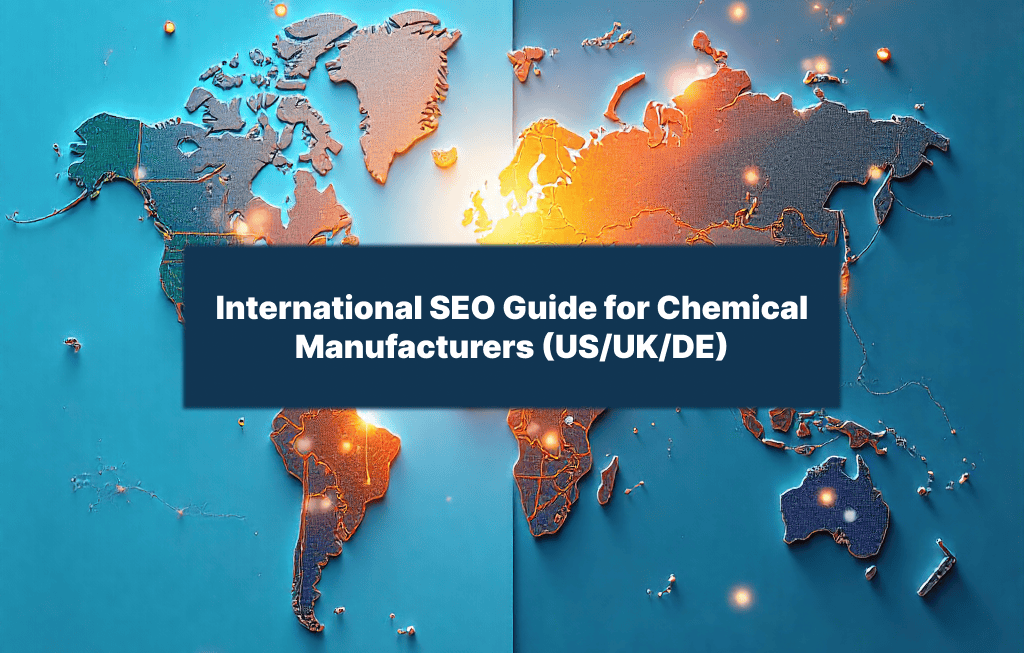International SEO Guide for Chemical Manufacturers (US/UK/DE)
6 mins | 10 Sept 2025
_488ed91b.png)
Introduction: Why Chemical SEO Must Go International
In conversations with chemical company CEOs, IT Heads, and Marketing Directors across India, Europe, and the US, one question keeps coming up:
“We export to 20+ countries, but our website only ranks in India. How do we show up where our buyers are searching?”
This is the heart of the problem. Chemical manufacturing is global by nature — products made in Mumbai are bought in Munich, Memphis, or Manchester. Yet most chemical websites are designed for domestic visibility only.
That’s where International SEO (Search Engine Optimization) comes in. Done right, it ensures that when a procurement manager in Germany searches “REACH-compliant stabilizers supplier” or a distributor in the US looks for “Aroma chemicals bulk supplier”, your company shows up — not just BASF, Sigma-Aldrich, or Dow.
This guide is built specifically for chemical manufacturers targeting the US, UK, and Germany — three of the most competitive and compliance-heavy markets.
The Unique SEO Challenges for Chemical Manufacturers
Unlike e-commerce or SaaS, chemical SEO has its own quirks:
Technical Language vs Buyer Language
- R&D scientists search by specs (“purity 99.5% benzyl alcohol”).
- Procurement searches by application + compliance (“food-grade stabilizer supplier UK”).
- Marketing teams often miss this gap.
Heavy Reliance on PDFs
- Datasheets and SDS dominate — but PDFs don’t rank well on Google.
Global vs Local
- Buyers in Germany search in German, often with REACH context.
- UK buyers may search “chemical distributors UK” instead of “manufacturers.”
- US buyers mix compliance with commercial intent (“bulk supplier FDA-grade chemicals”).
Compliance-Driven Content
- REACH, RoHS, IFRA, FDA, ISO — buyers often add compliance tags to searches.
- Many chemical sites don’t structure compliance pages for SEO.
Step 1: Keyword Research with Regional Context
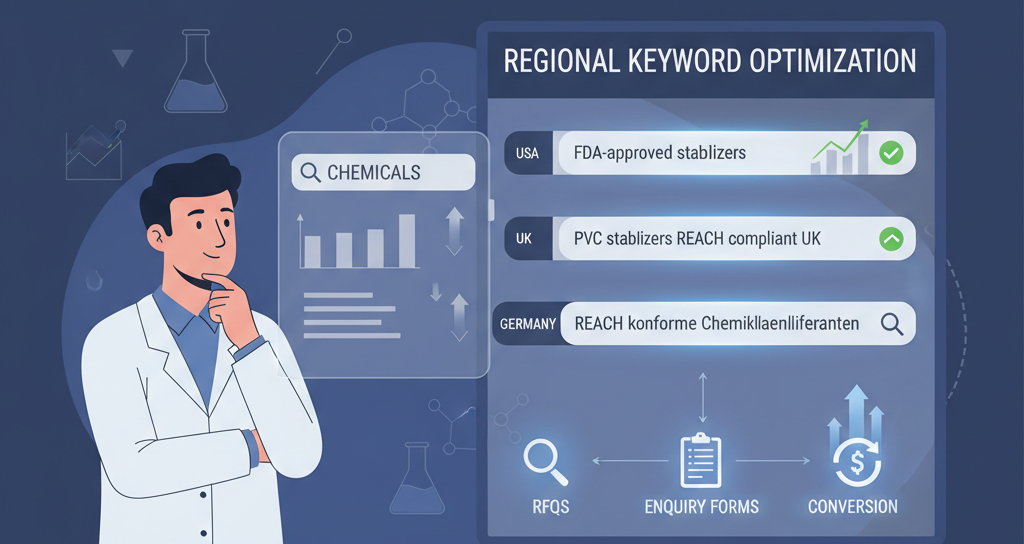
International SEO starts with understanding what buyers actually search in each market.
Example Keywords (US/UK/DE)
US
- “bulk chemical supplier USA”
- “FDA-approved stabilizers”
- “aroma chemicals wholesale US”
UK
- “chemical distributors UK”
- “PVC stabilizers REACH compliant UK”
- “specialty chemical supplier London”
Germany (DE)
- “chemische Zusätze Hersteller Deutschland” (chemical additives manufacturer Germany)
- “REACH konforme Chemikalienlieferanten” (REACH-compliant chemical suppliers)
- “Aroma Chemikalien Großhandel Deutschland” (aroma chemicals wholesale Germany)
👉 Action Tip: Use tools like SEMrush/Ahrefs, but also interview distributors & sales teams to capture industry phrases. Translate & validate German keywords with native experts. To ensure precision, align your chemical keyword research strategy with buyer-specific language and search intent.
Step 2: Multilingual & Regional SEO Setup
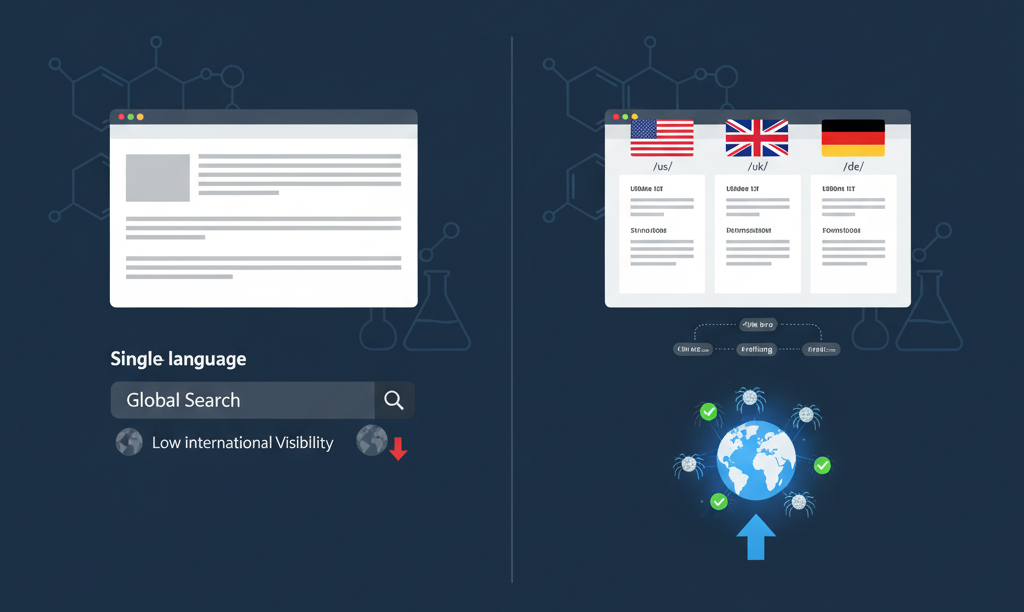
1. Hreflang Tags
Tell Google which version of your site is for which region. Example:
<link rel="alternate" hreflang="en-us" href="https://example.com/us/" />
<link rel="alternate" hreflang="en-gb" href="https://example.com/uk/" />
<link rel="alternate" hreflang="de-de" href="https://example.com/de/" />
Without hreflang, Google might serve your India site to German buyers — hurting conversions. This is one of many common SEO mistakes chemical companies often make when expanding globally.
2. URL Structure
Best practice for chemicals:
- example.com/us/ → US
- example.com/uk/ → UK
- example.com/de/ → Germany
This allows you to localize content, pricing, distributors without duplicating everything.
3. Translation vs Localization
- Don’t just translate datasheets — localize keywords, compliance terms, and CTAs.
- Example: In Germany, “REACH konform” works better than just “REACH compliant.”
Step 3: Structuring Datasheets & SDS for SEO
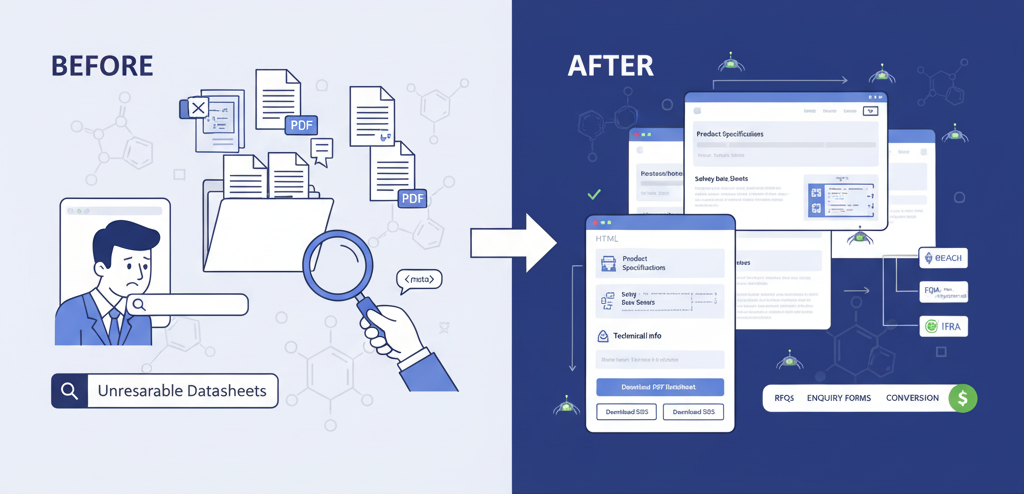
Datasheets and SDS are the lifeblood of chemical websites. But they’re often buried as PDFs.
What to Do Instead
- Create HTML landing pages for every datasheet → with specs, compliance badges, and structured data.
- Offer PDF as a download, but ensure Google indexes the HTML page.
- Add schema markup for Product + Compliance.
👉 Example: Instead of example.com/datasheet.pdf, build example.com/products/pvc-stabilizer-grade-a.
Result: US/UK/DE buyers searching “food-grade PVC stabilizer datasheet” will find you — not just your competitor’s PDF.
Step 4: Compliance Content as SEO Assets
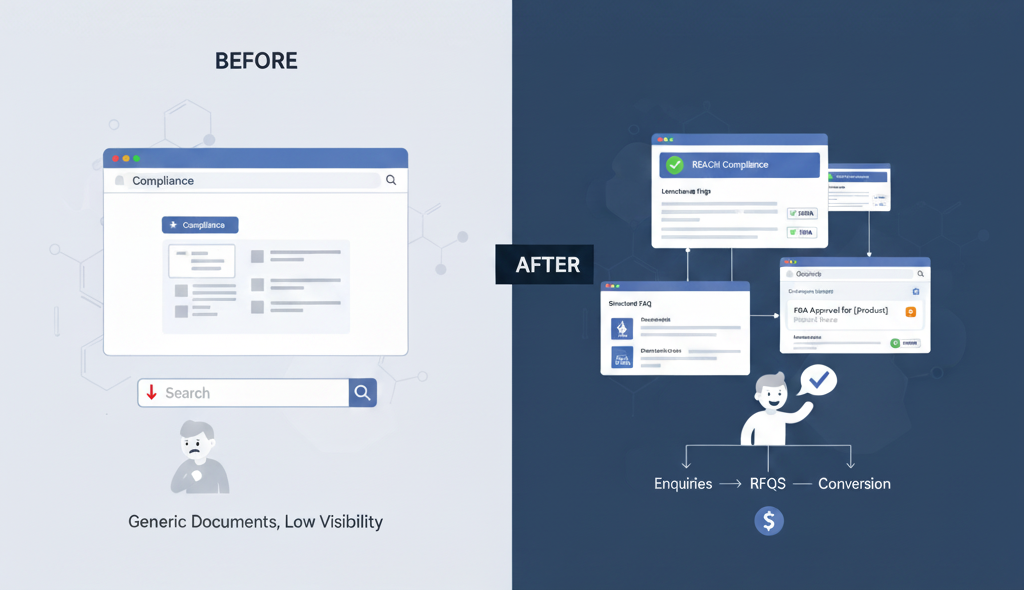
Compliance is not just paperwork — it’s a keyword goldmine.
How to Use It
- Create dedicated SEO pages for:
- “REACH compliant stabilizers supplier”
- “FDA-approved aroma chemicals”
- “IFRA-certified fragrance ingredients Germany”
- Add structured FAQs: “What is REACH compliance?”, “Which products are FDA-approved?”
👉 German buyers especially search with compliance first — building trust before pricing. This also underscores the growing importance of E-E-A-T principles in SEO for chemicals, especially in trust-heavy markets.
Step 5: Content Strategy for International Markets
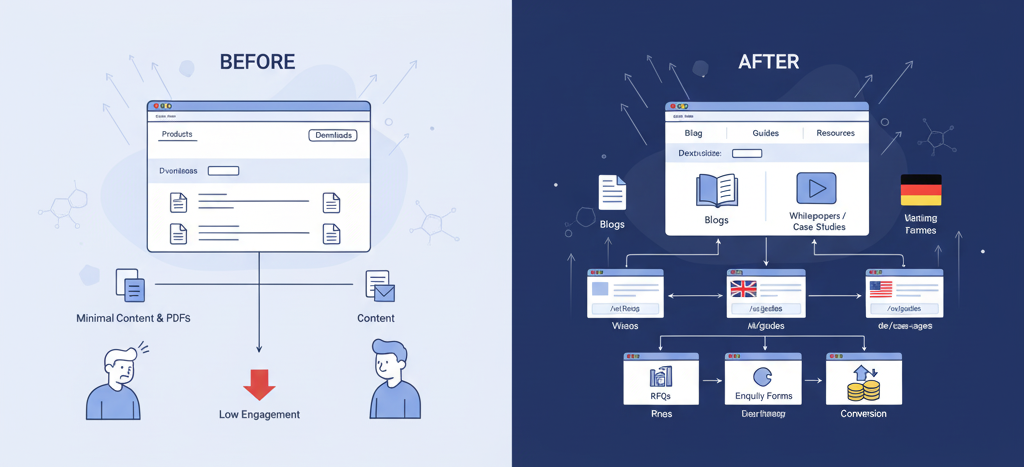
To win in SEO, chemical companies must go beyond product pages.
3 Types of Content That Work Globally
Listicles
- “Top 10 Aroma Chemical Suppliers in Germany”
- “5 Best FDA-Compliant Stabilizers for Packaging”
Guides & Whitepapers
- “Complete REACH Compliance Checklist for Buyers”
- “Understanding IFRA Regulations for Fragrance Chemicals”
Case Studies
- Showcase successful projects with US/UK/DE clients.
- Add real numbers: “Reduced sourcing time by 30%.”
To enhance impact, apply a keyword clustering strategy for SEO across these regional content formats.
👉 Action: Publish 2 articles/month per region linked back to product/service pages.
Step 6: Technical SEO for Chemicals
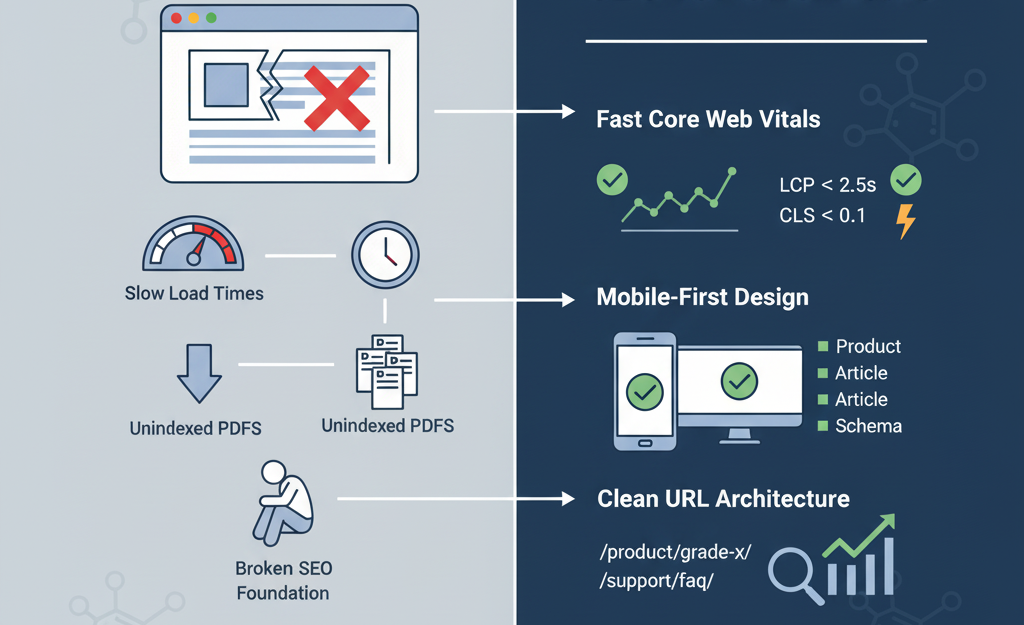
Chemical websites are heavy on PDFs, tables, and complex navigation. Technical SEO is non-negotiable.
Checklist
- Core Web Vitals: LCP < 2.5s, CLS < 0.1, INP < 200ms.
- Structured Data: Product schema, FAQ schema, Article schema.
- Mobile-first: Many procurement managers search on phones.
- Clean architecture: /us/products/ vs /products-us/ (consistency matters).
For advanced setup, refer to SEO strategy guide tailored for B2B manufacturing and export-heavy sites.
Step 7: Backlinks & Authority in US/UK/DE
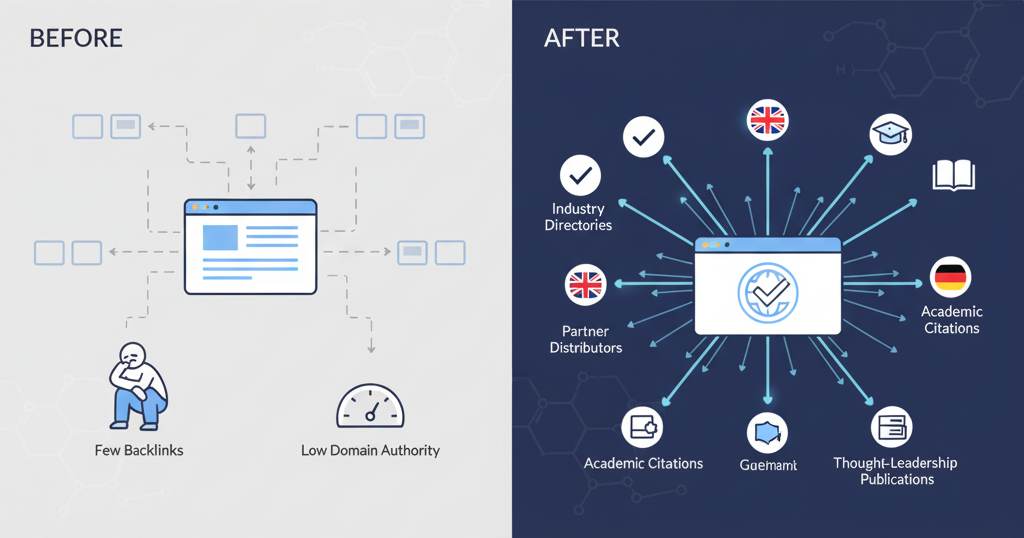
Search isn’t just about content. Google ranks based on authority.
How to Build Authority
- Industry directories: Get listed in chemical directories (ICIS, ChemEurope, ChemUK).
- Partnerships: Collaborate with distributors in Germany/UK for backlinks.
- Thought Leadership: Publish in magazines (Chemical Week, ChemEurope).
- Academic Citations: Offer open-access whitepapers that universities can cite.
👉 A backlink from chemistryworld.com (UK) is far more valuable than 20 random links. Explore how to get high-quality backlinks in global markets to build authority faster.
Step 8: Measurement & KPIs
SEO without measurement is noise.
Track These Metrics
- Regional traffic growth (US/UK/DE separately).
- Leads from each region (form fills, datasheet opt-ins, distributor contacts).
- Ranking keywords for compliance + product terms.
- Conversion rate per country (visitors → enquiries).
Tools: GA4, Search Console, SEMrush, AHREF with regional tracking.
Conclusion: The Global Buyer is Already Searching
Chemical buyers in the US, UK, and Germany are not waiting for trade shows or distributor calls. They’re searching online — right now — for compliant, reliable suppliers.
The question is: will they find your company, or only the global giants?
International SEO is not just a marketing tactic. For chemical manufacturers, it’s a strategic advantage — the difference between being invisible and being the supplier of choice.
If you want your chemical website to act as a global growth engine, start with these 7 steps. Within 90 days, you’ll not only see more traffic — you’ll see enquiries from markets that matter most.
Author

Share
Other Articles
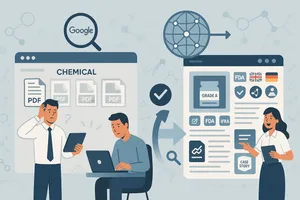
Why Most Chemical Suppliers Fail Google Search (and How to Fix It)
6 mins : 10 Sept 2025
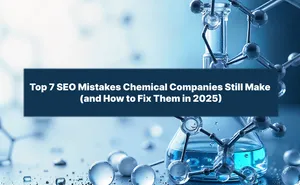
Top 7 SEO Mistakes Chemical Companies Still Make (and How to Fix Them in 2025)
5 mins : 09 Sept 2025

What Is Website Analysis? How To Analyse Your Website In 5 Simple Steps
6 mins : 08 Apr 2024
